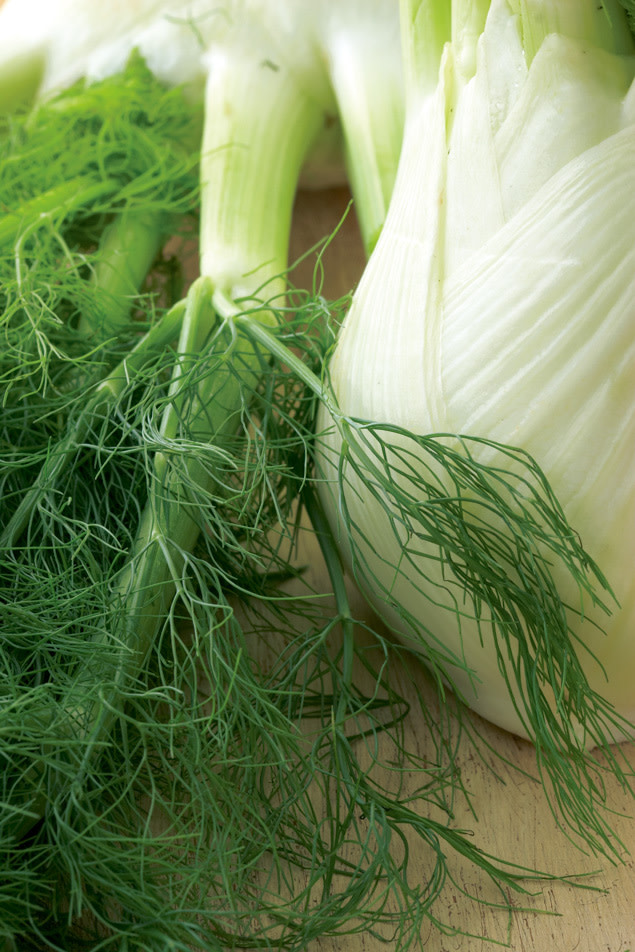The Licorice Myth

Image: Lara Ferroni
WHEN MY DAUGHTER was a toddler, she had a rather unusual teething snack: wild fennel pulled straight from the ground during our walks in the Hollywood Hills in Los Angeles. If she found the flavor bracing, she didn’t let on, gnawing the crunchy stalks until they were as flat as Popsicle sticks.
"It’s the yuppie sugarcane," says Leather Storrs, owner and chef of the newly opened restaurant Rocket on E Burnside St. "And it grows here, too. I’ve seen a giant swath of wild fennel by the off-ramp of the Hawthorne Bridge in Southeast Portland."
Storrs, formerly the chef at Noble Rot, has long incorporated the flavorful vegetable into his menus. But he doesn’t use the kind that pops up under freeways. That variety is known as wild or bitter fennel; its seeds and oils are found in items as varied as Italian sausage and toothpaste. Instead, Storrs uses Florence fennel, also known as bulb fennel or finocchio, a vividly ornamental vegetable with a broad white bulb, celerylike pale-green ribs and feathery fronds.
Despite its growing availability in grocery stores over the last decade or so, however, it can still be a hard sell. "Fennel is, unfortunately, a maligned vegetable, because people think it will taste like black licorice," Storrs explains.
When eaten raw, this member of the parsley family does have a sweet anise kick, but it’s more like licorice drenched in cold, clear water–much subtler than black licorice or fennel seed. Add a little citrus, however, and fennel’s anise hit goes herbaceous.
"Raw fennel can have a resonant, Pernod quality," says Storrs. "But if you acidulate it with salt and two lemons, you bring out its tarragon brightness."
Another way to play with fennel’s complex flavor is to braise it. (Storrs suggests halving the bulbs, tossing them in olive oil and salt, placing them cut side down in a Pyrex dish with a little water, and baking them at 250 degrees for 45 minutes.) Come summertime, however, you might prefer its snap in fresh summer salads–it tastes best in such dishes when sliced about an eighth of an inch thick to soften its flavor.
"The thing that’s also cool about fennel is, it comes with its own handle," Storrs says. "You cut most of the green stalks, but leave some to grab onto when you’re slicing it."
As for the stalks, which most people tend to discard, Storrs suggests tossing them into a pot of fish stock. "They’re subtle this way," he says. "It doesn’t yell, I’m fennel!"

Shaved Fennel and Butter Lettuce Salad with Cauliflower-Orange Vinaigrette
Recipe Courtesy Leather Storrs, chef and owner of Rocket restaurant.
Serves 4
INGREDIENTS
- 1 large fennel bulb
- Juice of 1 lemon
- 1 tsp salt
- ¾ cup cauliflower florets, stems removed
- Juice of 3 oranges, plus more to taste
- 2 tsp Dijon mustard
- ½ cup olive oil
- ½ shallot, minced
- 2 heads butter lettuce, trimmed, leaves washed
- 1 handful black Cerignola or Niçoise olives, pitted, coarsely chopped
- 2 tbsp chives, finely chopped
- Salt and pepper to taste
- Trim fronds and stalks from fennel. Remove the core from the bulb, and shave or slice into 1/8-inch-thick pieces. Toss with lemon juice and salt, cover and refrigerate one hour, then drain fennel and set aside.
- To prepare the cauliflower-orange vinaigrette, finely chop cauliflower florets.
- In a small saucepan over medium heat, simmer cauliflower with orange juice and a dash of salt until tender, about 7-10 minutes. Drain.
- In a small bowl, whisk together mustard, olive oil and minced shallot; stir in cauliflower, and season with salt, pepper and fresh orange juice to taste.
- To arrange the salad, toss whole leaves of butter lettuce with vinaigrette and arrange on plates, placing big leaves on bottom, setting smaller leaves on top, and sprinkling each layer of lettuce with a little fennel and a little chopped olive.
- Garnish with chopped chives.




